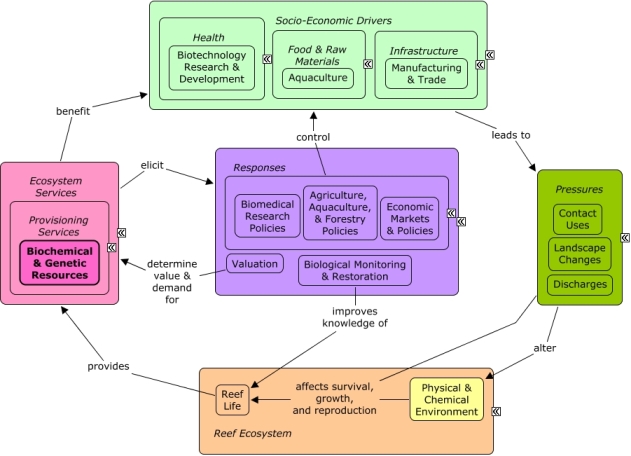ReefLink Database

Biochemical & Genetic Resources
Biochemical & genetic resources are the naturally available novel biochemicals and genetic information found in coral reef organisms that can be utilized for animal breeding or development of biotechnology.
CMap

CMap Description
Reef organisms, including fish and invertebrates, provide a number of biochemical and genetic resources that provide research and development opportunities for biomedical products, including development of new pharmaceuticals. Aquaculture may also benefit from genetic resources, by improving domesticated stock through interbreeding with wild individuals. Many of the socio-economic sectors that depend on development of new products that improve human health and quality of life, also create pressures on the reef through coastal development, pollution, and harvesting. Economic markets will drive the demand for new and improved products. Aquaculture and biomedical research policies can control demand funding for research, and the need for natural biochemical and genetic resources.Citations
More than 50 citations. Click here to load.
| Citation | Year | Study Location | Study Type | Database Topics |
|---|
Management Options
| Management Option | Description | Sources | Database Topics |
|---|---|---|---|
| Corporate Response: Invest & Co-finance Projects | Investing and co-financing projects that aim to conserve or restore habitats can be an effective means to preserving reef habitats as well as establishing positive working relationships between organizations. Investing in private sector projects will promote desired businesses and business practices, reducing barriers to entry and competitiveness as compared to traditional businesses and business practices to counterbalance advantages from undesired externalities. | World Bank Group. 2008. Biodiversity, Climate Change, and Adaptation. Nature based solutions from the world bank portfolio. The International Bank for Reconstruction and Development, Washington, DC. |
Aquarium Stock; Banks, Credit, & Securities; Biochemical & Genetic Resources; Biomedical Research Policies; Collaboration & Partnering; Corporate Responses; Economic Markets & Policies; Finance & Insurance; Finfish & Shellfish Stock; Food & Raw Materials; Funding & Donations; Funding & Incentives; Manufacturing & Trade; Manufacturing & Trade Policies; Marine Products; Ornamental Jewelry & Art; Pharmaceuticals & Cosmetics Sources; Provisioning Services; Resource Use Management; Tourism & Recreation |
| Economic Markets & Policy: Regulate International Trade of Reef Species | Many coral reef species are harvested internationally for a variety of markets including the aquarium trade, food, curios, jewelry and pharmaceuticals. The US is the largest importer for many of these markets. The US strictly limits extraction of stony coral and many reef species in its waters; but as a major importer and consumer of coral reef species, more actions can be taken to decrease the demand on international imports. Setting and enforcing regulations on what can be imported (such as Convention on International Trade in Endangered Species CITES) is one approach that has been taken. More information is needed, leaving room to collect trade data and assess the impacts of extraction techniques to find sustainable methods. Demand for species collected this way will be increased with greater transparency to consumers, which can be accomplished through certifications for environmentally cognoscente collectors and those using alternatives like aquaculture and coral farming. Continued participation in Asia Pacific Economic Cooperation (APEC) and International Coral Reef Initiative (ICRI) is also beneficial. | U.S. Coral Reef Task Force. 2000. International Trade in Coral and Coral Reef Species: The Role of the United States. Report of the Trade Subgroup of the International Working Group to the U.S. Coral Reef Task Force, Washington, D.C. World Resource Institute International Marinelife Alliance, editor. 1997. Sullied Seas. WRI, Washington D.C. U.S. Coral Reef Task Force. 2000. The National Action Plan to Conserve Coral Reefs. Washington, D.C. |
Accidental & Illegal Harvest; Aquaculture; Aquarium & Pet Trade; Aquarium Stock; Biological Harvest; Biological Monitoring, Mapping, & Scientific Research; Collaboration & Partnering; Coral; Corporate Responses; Cultural Policies; Designate Protected Species; Economic Markets & Policies; Environmental Education & Outreach; Invertebrate Harvest; Invertebrates; Live Collection; Manufacturing & Trade; Manufacturing & Trade Policies; Marine Products; Ornamental Jewelry & Art; Pharmaceuticals & Cosmetics; Pharmaceuticals & Cosmetics Sources; Political Pressure; Souvenir & Decorative Trade; Sponges; Stony Coral; Toxics; Wholesale & Retail Trade |
| Marine Zoning: Ecological Reserves (ERs) | Ecological Reserves set aside areas with minimal human interference. These reserves aim to enhance and protect biodiversity through encompassing large, contiguous habitats. The goal of ecological reserves is to encourage spawning, nurseries, and residence areas that contribute to genetic protection of fish and marine life. Ecological Reserves can be achieved through a variety of methods such as: placing/maintaining buoys along zone boundaries; adjusting boundaries if necessary; evaluating allowable activities within zone boundaries; identifying potential areas that need additional zoning; reviewing the effectiveness of the zoning; and revising NOAA and GIS charts. | NOAA Marine Sanctuary Program. 2007. Florida Keys National Marine Sanctuary revised management plan. National Ocean Service, Key West, FL. |
Biochemical & Genetic Resources; Biological Addition; Biological Harvest; Biological Monitoring & Restoration; Boating Activities; Boating Regulations; Coastal Defense; Commercial Fishing Boats; Complex Habitat & Resources; Cruise Ships; Decision Support; Designated Uses; Dredging Regulations; Dredging, Draining, & Filling; Ecosystem Monitoring & Restoration; Environmental Monitoring & Restoration; Finfish Harvest; Fisheries & Hunting Policies; Fishing & Harvesting Management; Fishing Sector; Invertebrate Harvest; Large Ships; Live Collection; Marine Protected Areas; Oil & Gas Tankers; Permitting & Zoning; Physical Damage; Provisioning Services; Resource Use Management; Security Policies; Small Boats; Tourism & Recreation; Trampling; Water Transportation |
| Monitor & Research: Biological Status and Trends Monitoring | This activity produces long-term comprehensive information on sanctuary-wide status and trends of biological resources. Data that could be collected on coral reef communities includes but is not limited to species abundance and density, biodiversity, benthic cover, coral condition, growth, recruitment, predation, and grazing. Mangroves and seagrasses should also be monitored. With adequate baseline data, changes in community structure and biocriteria can be identified and restoration or protection efforts can be taken. | NOAA Marine Sanctuary Program. 2007. Florida Keys National Marine Sanctuary revised management plan. National Ocean Service, Key West, FL. |
Algae; Anemones & Zooanthids; Apex Fish Predators; Aquaculture; Aquarium Stock; Biochemical & Genetic Resources; Biocriteria; Biological Harvest; Biological Monitoring & Restoration; Biological Monitoring, Mapping, & Scientific Research; Bivalves; Calcareous Macroalgae; Contact Uses; Coral; Coralline Algae; Cyanobacteria; Decision Support; Echinoderms; Ecosystem Monitoring & Restoration; Finfish & Shellfish Stock; Fish; Fishing Sector; Food & Energy Policies; Hydrocoral; Invasive Species; Invertebrates; Large Herbivorous Fish; Lobster, Crab, & Shrimp; Mangroves; Marine Birds; Marine Products; Marine Vertebrates; Marine Worms; Microorganisms; Molluscs; Octocoral; Octopus & Squid; Ornamental Jewelry & Art; Pathogens; Pharmaceuticals & Cosmetics Sources; Physical Damage; Primary Production; Provisioning Services; Resource Use Management; Sea Turtles; Sea Urchins; Seagrasses; Seastars; Skeletal Coral; Small Herbivorous Fish; Snails & Conch; Sponges; Stony Coral; Tunicates; Wetlands; Whales & Dolphins |
| Resource Use Management: Seasonal Fisheries and Harvesting | Finfish and shellfish stocks may be more or less susceptible to fishing pressures during certain times of the year. This may be due to seasonality of recruitment and/or changes in food/predation pressures. If fishing restrictions may be more successful if this seasonality is taken into consideration and fishing pressure adjusted accordingly. | Accidental & Illegal Harvest; Apex Fish Predators; Artisanal Fishing; Biochemical & Genetic Resources; Biological Harvest; Bivalves; Commercial Fisheries; Corallivorous Fish; Decision Support; Echinoderms; Finfish & Shellfish Stock; Finfish Harvest; Fish; Fisheries & Hunting Policies; Fishing & Harvesting Management; Fishing Sector; Food & Energy Policies; Invertebrate Harvest; Invertivorous Fish; Large Herbivorous Fish; Live Collection; Lobster, Crab, & Shrimp; Marine Products; Molluscs; Octopus & Squid; Permitting & Zoning; Piscivorous Fish; Planktivorous Fish; Provisioning Services; Recreational Fishing; Small Herbivorous Fish; Snails & Conch; Sponges; Tourism & Recreation Policies | |
| Resource Use Management: Develop Regulations for Sponge Fisheries | Sponges play a vital role on reefs, providing structure, food and filtration. Depending on the method of removal, this process can be very destructive to other reef fauna and habitat. Research is needed to compare impacts of different sponge fishing methods in different areas. | NOAA Marine Sanctuary Program. 2007. Florida Keys National Marine Sanctuary revised management plan. National Ocean Service, Key West, FL. |
Accidental & Illegal Harvest; Biochemical & Genetic Resources; Biological Harvest; Biological Monitoring, Mapping, & Scientific Research; Boring Sponges; Commercial Fisheries; Contact Uses; Culture; Cyanobacteria; Educational & Research Opportunities; Encrusting Sponges; Finfish Harvest; Fisheries & Hunting Policies; Fishing & Harvesting Management; Fishing Sector; Invertebrate Harvest; Live Collection; Marine Products; Microorganisms; Nutrient & Contaminant Processing; Pharmaceuticals & Cosmetics Sources; Physical Damage; Resource Use Management; Scientific Research; Sponges; Tourism & Recreation; Tourism & Recreation Policies; Trawling & Fishing Gear Damage; Tube, Barrel, & Finger Sponges |
| Resource Use Management: Develop Live Collection Regulations | Live collection is often more destructive than capture of food fishes because of the destructive methods used to remove live fish and invertebrates from the reef habitat. These methods include use of cyanide and explosives. Current methods should be assessed and alternatives should be developed or collection prohibited. | World Resource Institute International Marinelife Alliance, editor. 1997. Sullied Seas. WRI, Washington D.C. |
Accidental & Illegal Harvest; Aquarium & Pet Trade; Biochemical & Genetic Resources; Biological Harvest; Biological Monitoring, Mapping, & Scientific Research; Commercial Fisheries; Contact Uses; Educational & Research Opportunities; Finfish Harvest; Fisheries & Hunting Policies; Fishing & Harvesting Management; Fishing Sector; Invertebrate Harvest; Live Collection; Marine Products; Pharmaceuticals & Cosmetics Sources; Physical Damage; Resource Use Management; Scientific Research; Sponges; Toxics; Trawling & Fishing Gear Damage; Wholesale & Retail Trade |
Laws
| Legal Citation | Purpose of Law | Management Organization | Database Topics |
|---|
